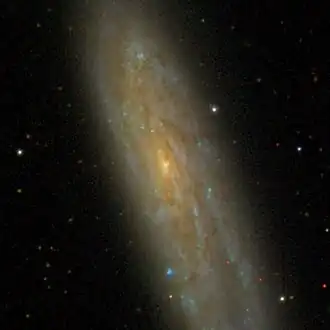NGC 4096
| NGC 4096 | |
|---|---|
 NGC 4096 by Sloan Digital Sky Survey | |
| Observation data (J2000 epoch) | |
| Constellation | Ursa Major |
| Right ascension | 12h 06m 01.1138s[1] |
| Declination | +47° 28′ 42.834″[1] |
| Redshift | 0.001908 ± 0.000007[1] |
| Heliocentric radial velocity | 572 ± 2 km/s[1] |
| Distance | 37.5 ± 7.8 Mly (11.5 ± 2.4 Mpc)[1] |
| Apparent magnitude (V) | 10.8[2] |
| Characteristics | |
| Type | SAB(rs)c [1] |
| Apparent size (V) | 4.39′ × 1.04′[1] |
| Other designations | |
| IRAS 12034+4745, UGC 7090, MCG +08-22-067, PGC 38361, CGCG 243-043[1] | |
NGC 4096 is a spiral galaxy in the constellation Ursa Major. The galaxy lies about 35 million light years away from Earth, which means, given its apparent dimensions, that NGC 4096 is approximately 80,000 light years across.[1] It was discovered by William Herschel on March 9, 1788.[3]
NGC 4096 is a spiral galaxy visible with an inclination of 76°.[4] Although the presence of a bar has been suggested, it hasn't been proven.[5] The galaxy has multiple well-defined thin arms.[6] NGC 4096 is asymmetric in the north–south axis, with the northern half having stronger CO emissions[7] and asymmetric HI and H-alpha emissions following a lopsided spiral arm.[8] The total stellar mass of the galaxy is estimated to be (6.13±0.1)×109 M☉.[9] The star formation rate of the galaxy is estimated to be between 0.22 and 0.43 M☉ per year.[4]
Garcia in 1993 considered the galaxy to be a member of LGG 269 group, along with NGC 4111, NGC 3938, NGC 4051, and NGC 4138.[10] On the other hand, Makarov et al. consider the galaxy to be a member of the Messier 106 Group, along with Messier 106, NGC 4242, NGC 4248, NGC 4288 and NGC 4460.[11] The group is part of the Local Supercluster.[12]
Supernovae
Two supernovae have been detected in NGC 4096.[13]
- SN 1960H (Type Ia-pec, mag. 14) was discovered by Milton Humason on 17 June 1960, and independently by Paul Wild on 20 June 1960.[14][15][16]
- SN 2014bi (Type II-P, mag. 18.2) was discovered by the Lick Observatory Supernova Search (LOSS) on 31 May 2014.[17] It was low-luminosity, and the spectrum indicated it was about two weeks post maximum and significantly reddened.[18][19]
References
- ^ a b c d e f g h i "Results for NGC 4096". NASA/IPAC Extragalactic Database. Retrieved 2024-03-26.
- ^ "Revised NGC Data for NGC 4096". spider.seds.org. Retrieved 30 March 2024.
- ^ Seligman, Courtney. "NGC 4096 (= PGC 38361)". Celestial Atlas. Retrieved 19 November 2018.
- ^ a b Manna, Souvik; Roy, Subhashis (1 February 2023). "Magnetic Fields, Star Formation Rates, and Gas Densities at Sub-kiloparsec Scales in a Pilot Sample of Nearby Galaxies". The Astrophysical Journal. 944 (1): 86. arXiv:2301.03752. Bibcode:2023ApJ...944...86M. doi:10.3847/1538-4357/acaf64.
- ^ Dullo, B. T.; Knapen, J. H.; Beswick, R. J.; Baldi, R. D.; Williams, D. R. A.; McHardy, I. M.; Gallagher, J. S.; Aalto, S.; Argo, M. K.; Gil de Paz, A.; Klöckner, H.-R.; Marcaide, J. M.; Mundell, C. G.; Mutie, I. M.; Saikia, P. (July 2023). "LeMMINGs: V. Nuclear activity and bulge properties: A detailed multi-component decomposition of e -MERLIN Palomar galaxies with HST". Astronomy & Astrophysics. 675: A105. arXiv:2303.11154. Bibcode:2023A&A...675A.105D. doi:10.1051/0004-6361/202345913.
- ^ Sandage, A., Bedke, J. (1994), The Carnegie Atlas of Galaxies. Volume I, Carnegie Institution of Washington
- ^ Sofue, Yoshiaki; Tutui, Yoshinori; Honma, Mareki; Tomita, Akihiko (December 1997). "Nuclear Rotation Curves of Galaxies in the Co-Line Emission". The Astronomical Journal. 114: 2428. arXiv:astro-ph/9709115. Bibcode:1997AJ....114.2428S. doi:10.1086/118657.
- ^ Zheng, Yun; Wang, Jing; Irwin, Judith; English, Jayanne; Ma, Qingchuan; Wang, Ran; Wang, Ke; Wang, Q Daniel; Krause, Marita; Randriamampandry, Toky H; Li, Jiangtao; Beck, Rainer (29 April 2022). "CHANG-ES XXV: H i imaging of nearby edge-on galaxies – Data Release 4". Monthly Notices of the Royal Astronomical Society. 513 (1): 1329–1353. arXiv:2203.07818. doi:10.1093/mnras/stac760.
- ^ Lu, Li-Yuan; Li, Jiang-Tao; Vargas, Carlos J; Beck, Rainer; Bregman, Joel N; Dettmar, Ralf-Jürgen; English, Jayanne; Fang, Taotao; Heald, George H; Li, Hui; Qu, Zhijie; Rand, Richard J; Stein, Michael; Wang, Q Daniel; Wang, Jing; Wiegert, Theresa; Zheng, Yun (17 January 2023). "eDIG-CHANGES I: extended Hα emission from the extraplanar diffuse ionized gas (eDIG) around CHANG-ES galaxies". Monthly Notices of the Royal Astronomical Society. 519 (4): 6098–6110. arXiv:2212.14824. doi:10.1093/mnras/stad006.
- ^ Garcia, A. M. (1 July 1993). "General study of group membership. II. Determination of nearby groups". Astronomy and Astrophysics Supplement Series. 100: 47–90. Bibcode:1993A&AS..100...47G. ISSN 0365-0138.
- ^ Makarov, Dmitry; Karachentsev, Igor (21 April 2011). "Galaxy groups and clouds in the local (z~ 0.01) Universe". Monthly Notices of the Royal Astronomical Society. 412 (4): 2498–2520. arXiv:1011.6277. Bibcode:2011MNRAS.412.2498M. doi:10.1111/j.1365-2966.2010.18071.x. S2CID 119194025.
- ^ G. De Vaucouleurs, 1975. Nearby Groups of Galaxies, ch. 5. the nearer groups within 10 megaparsecs. Published in "Galaxies and the Universe," ed. by A. Sandage, M. Sandage and J. Kristian
- ^ "Bright Supernova pages - Most prolific galaxies". www.rochesterastronomy.org. Retrieved 12 April 2024.
- ^ Humason, Milton (24 June 1960). "Supernova Humason". Central Bureau for Astronomical Telegrams. 1731. Observatory Copenhagen, IAU: 1. Retrieved 15 August 2025.
- ^ Wild, Paul (2 July 1960). "Supernova Humason". Central Bureau for Astronomical Telegrams. 1732. Observatory Copenhagen, IAU: 1. Retrieved 15 August 2025.
- ^ "SN 1960H | Transient Name Server". www.wis-tns.org. Retrieved 12 April 2024.
- ^ Kumar, S.; Zheng, W.; Filippenko, A. V.; Masi, G.; Zhang, J. -j.; Wang, X. -f. (2014). "Supernova 2014bi in NGC 4096 = PSN J12060299+4729335". Central Bureau Electronic Telegrams (3892): 1. Bibcode:2014CBET.3892....1K.
- ^ "SN 2014bi | Transient Name Server". www.wis-tns.org. Retrieved 12 April 2024.
- ^ Zhang, Jujia; Wang, Xiaofeng (1 June 2014). "Spectroscopic Classification of PSN J12060299+4729335 as A Low-Luminosity Type II-P Supernova". The Astronomer's Telegram. 6192: 1. Bibcode:2014ATel.6192....1Z.
External links
- NGC 4096 on WikiSky: DSS2, SDSS, GALEX, IRAS, Hydrogen α, X-Ray, Astrophoto, Sky Map, Articles and images